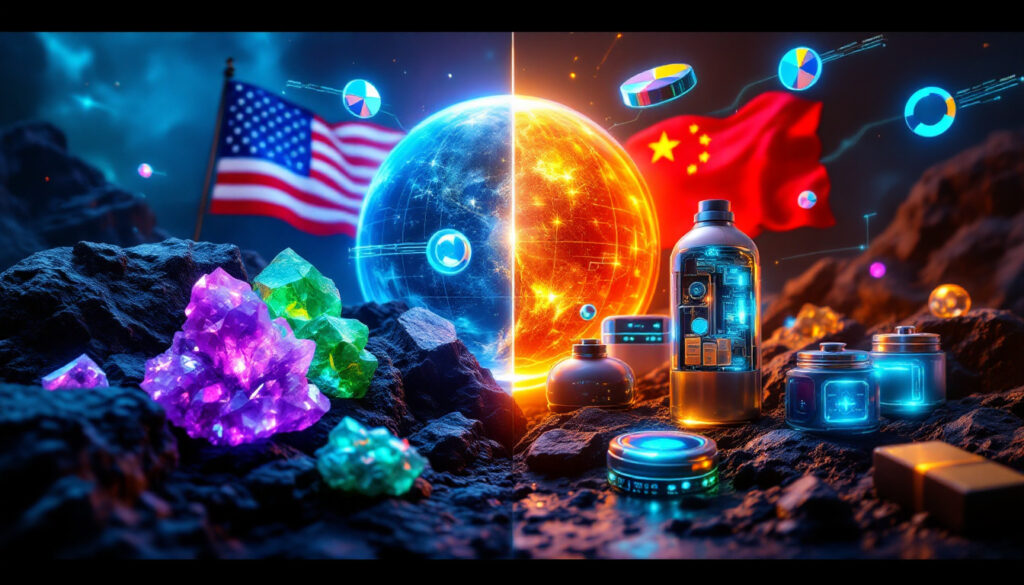What Are Rare Earth Minerals and Why Do They Matter in Global Trade?
Rare earth minerals represent one of the most strategic resources in modern global trade despite their relative obscurity to the general public. These elements form the backbone of technological innovation, green energy development, and advanced defense systems that define 21st-century economic competition.
The Critical Role of Rare Earth Elements in Modern Technology
Rare earth elements (REEs) comprise a group of 17 metallic elements found in the Earth's crust. Despite their name, most are relatively abundant, but they rarely occur in concentrated, economically viable deposits. What makes these elements extraordinary is their unique magnetic, luminescent, and electrical properties that cannot be easily replicated by other materials.
These elements are crucial components in:
- Consumer electronics: Smartphones, laptops, and tablets rely on rare earths for vibration motors, speakers, and display technologies
- Clean energy technologies: Wind turbines require up to 2 tons of rare earth magnets per megawatt of capacity
- Electric vehicles: Each EV typically contains 1-2 kg of rare earth metals in motors and battery systems
- Defense applications: Precision-guided munitions, radar systems, and night vision equipment
The significance of critical raw materials extends beyond their technological applications. As Professor Wang Xiaosong of Renmin University notes, "These minerals represent a strategic leverage point in modern trade relations that transcends their market value."
"Rare earths are the vitamins of modern industry – small in quantity but vital to functionality." – Materials science axiom frequently cited in industry publications
China's Dominant Position in the Global Rare Earth Supply Chain
China's strategic foresight regarding rare earths dates back to the 1980s when Deng Xiaoping famously remarked, "The Middle East has oil, China has rare earths." Today, that vision has manifested in overwhelming market dominance:
- Controls approximately 85% of global processing capacity
- Produces over 70% of the world's rare earth elements
- Maintains the most sophisticated separation facilities for "heavy" rare earths
- Holds approximately 37% of global rare earth reserves
This dominance didn't happen overnight. China systematically built its rare earth advantage through:
- Decades of strategic investment in mining infrastructure and processing technology
- Consolidated industry structure through mergers of key producers
- Development of technical expertise in complex separation processes
- Vertical integration of the entire supply chain from mining to magnet manufacturing
The country's comparative advantage stems not just from geological luck but from deliberate policy choices that prioritized developing expertise in processing these critical minerals energy security when other nations showed little interest.
How Is China Using Rare Earth Minerals as Leverage in the Trade War?
China's approach to rare earth export policy has evolved from blunt restrictions to sophisticated strategic leverage. The country has refined its approach to maximize pressure while minimizing the risk of accelerating supply chain diversification.
The "Ace Up Its Sleeve" Strategy
Rather than deploying across-the-board restrictions that could trigger severe international backlash, China has adopted a surgical approach to rare earth export controls:
- Selective targeting: The April 4, 2025 restrictions focused specifically on seven "medium and heavy" rare earth metals including dysprosium and terbium
- Strategic applications: These particular elements are critical for high-performance magnets used in defense systems and advanced green technologies
- Limited scope: By restricting only certain elements rather than all rare earths, China maintained plausible deniability regarding trade weapon accusations
The market impact was immediate and severe. According to Zhongtai Securities research:
- Prices surged over 200% in overseas markets following the export controls
- Dysprosium oxide prices reached $485/kg, up from $152/kg in March
- Manufacturing companies scrambled to secure 3-6 month inventory buffers
This targeted approach represents a sophisticated evolution in China's trade leverage toolkit. It applies maximum pressure to sensitive sectors without triggering a full-scale economic confrontation that could accelerate U.S. diversification efforts.
The Kite-Flying Approach to Trade Negotiations
The term "kite-flying" aptly describes China's current rare earth strategy. As Wang Xiaosong explained in the South China Morning Post:
"Like flying a kite, China pulls back on restrictions when concessions are needed, then tightens again when leverage is required—all while maintaining the underlying control of the string."
This approach manifests in several ways:
- Moderate relaxation of controls as goodwill gestures during negotiations
- Temporary concessions that can be reversed if negotiations falter
- Balancing leverage with de-escalation to prevent pushing the U.S. toward desperate measures
- Maintaining the threat without delivering the most severe consequences
The recent trade truce exemplifies this strategy perfectly. By implicitly scrapping the April 4 restrictions while maintaining older limits on other critical minerals, China demonstrates flexibility while preserving its fundamental strategic advantage.
This calculated approach allows China to extract trade concessions without triggering the kind of urgent supply chain diversification that would undermine its long-term leverage position.
What Does the Current US-China Trade Truce Include?
The latest trade agreement between the economic superpowers represents a tactical pause rather than a strategic resolution to underlying tensions. Both sides have stepped back from the brink while maintaining their fundamental positions.
The 90-Day Agreement Framework
The May 2025 trade truce contains several key provisions:
- Pause or removal of non-tariff countermeasures imposed since April 2, 2025
- Lowering of most bilateral tariffs for a 90-day cooling period
- Implicit scrapping of April 4 curbs on "medium and heavy" rare earth metals
- Maintenance of earlier restrictions on other critical minerals, including certain rare earths
This agreement is notably time-bound and conditional. It creates a breathing space for further negotiations rather than resolving fundamental disagreements about trade practices, intellectual property, or industrial policy.
The rare earth provisions are particularly significant. While the most recent restrictions are being lifted, the underlying control infrastructure remains intact, ready to be deployed again if negotiations stall.
Strategic Calculations Behind the Temporary Reprieve
Both nations have clear strategic rationales for accepting this limited agreement:
For China:
- Prevents desperate countermeasures that might accelerate U.S. supply chain diversification
- Demonstrates diplomatic flexibility to international partners
- Maintains underlying leverage without forcing permanent alternatives
- Creates testing ground for potential permanent agreements
For the United States:
- Relieves immediate pressure on defense and technology manufacturers
- Provides time to develop medium-term sourcing alternatives
- Avoids immediate price increases for critical components
- Sends positive signals to financial markets concerned about escalation
As trade analysts at the Peterson Institute noted, "This agreement buys time for both sides, but fundamentally changes nothing about the strategic competition around critical mineral supply chains."
How Are Global Markets Responding to Rare Earth Trade Dynamics?
The fluctuating availability of rare earth elements has triggered significant market reactions that extend far beyond the mining sector. These developments showcase the widespread economic importance of these once-obscure materials.
Price Volatility and Supply Chain Uncertainty
The market impact of China's rare earth policy moves has been substantial:
- Extreme price swings: 200%+ increases for dysprosium, terbium and other restricted elements following April controls
- Market recalibration: Partial price stabilization following the trade truce announcement
- Risk premiums: Persistent price elevation compared to pre-tension levels
- Increased hedging: Forward contracts and stockpiling becoming standard practice
This volatility has rippled through manufacturing supply chains. According to industry reports:
| Element | Pre-Restriction Price | Peak Price | Current Price |
|---|---|---|---|
| Dysprosium oxide | $152/kg | $485/kg | $310/kg |
| Terbium oxide | $1,270/kg | $3,850/kg | $2,740/kg |
| Neodymium oxide | $87/kg | $225/kg | $165/kg |
"The days of just-in-time inventory for rare earth components are over. Companies that want to survive need buffer stocks and diversified sourcing." – Procurement director at a major electronics manufacturer
Industry Adaptation Strategies
Companies across multiple sectors are implementing multi-faceted approaches to rare earth vulnerability:
-
Diversification of sourcing:
- Australia's Lynas Rare Earths expanding production capacity by 50%
- MP Materials accelerating output at Mountain Pass mine in California
- Vietnam enhancing extraction capabilities at Son La province deposits
-
Technological adaptation:
- Toyota developing motors with 40% less neodymium
- Siemens Gamesa investing in rare earth-free wind turbine prototypes
- Recovery technologies extracting up to 90% of rare earths from electronic waste
-
Inventory management:
- Tech manufacturers increasing stock from 1-2 months to 4-6 months coverage
- Defense contractors securing multi-year supplies of critical elements
- Development of industry-wide monitoring systems for supply disruption
These adaptations represent significant costs to businesses, with JPMorgan analysts estimating a 3-5% increase in component costs across affected industries. However, they also indicate a growing recognition that rare earth supply chains require fundamental restructuring rather than temporary fixes.
What Are the Long-Term Implications for US Technology and Defense Industries?
The vulnerability of U.S. high-tech manufacturing and defense capabilities to rare earth supply disruptions presents profound strategic challenges that go far beyond routine trade concerns.
Vulnerability Assessment and Risk Mitigation
American technology and defense industries face multi-layered vulnerabilities:
- Defense systems: F-35 fighter jets contain approximately 417 kg of rare earth materials
- Green technology transition: Each EV requires 1-2 kg of rare earths; wind turbines need 600 kg per megawatt
- Advanced manufacturing: Computer numerical control (CNC) machines, robots, and precision tools all depend on rare earth magnets
The Department of Defense has identified several critical systems with severe supply vulnerabilities:
- Precision-guided munitions
- Night vision equipment
- Satellite communications
- Radar systems
- Sonar systems
These vulnerabilities create cascading risks across civilian and military applications. As one Pentagon report concluded, "No modern military can maintain technological superiority without secure access to specific rare earth elements."
The Race to Develop Alternative Supply Chains
The United States has initiated a multi-pronged approach to rare earth vulnerability:
-
Domestic production revival:
- $140 million in Department of Energy funding for processing facilities
- Streamlined permitting for MP Materials' Mountain Pass expansion
- Defense Production Act invocation to support domestic separation capabilities
-
International partnerships:
- Australia-U.S. Critical Minerals Accelerator program ($250 million)
- Canada-U.S. Joint Action Plan on Critical Minerals Collaboration
- Japan-U.S. partnership providing $2.2 billion for ASEAN projects
-
Technological innovation:
- ARPA-E funding for rare earth alternatives ($35 million)
- Development of iron-nitride magnets as neodymium substitutes
- Urban mining technologies recovering elements from waste streams
-
Recycling initiatives:
- Recovery of up to 90% of rare earths from end-of-life products
- Development of circular economy frameworks for critical minerals
- Tax incentives for companies implementing rare earth recycling
These efforts face significant challenges. Domestic rare earth production currently meets less than 15% of U.S. needs, and developing processing capabilities comparable to China's could take 5-10 years and billions in investment.
How Might the Rare Earth Situation Evolve in Future Trade Negotiations?
The strategic importance of rare earth elements ensures they will remain a central feature of U.S.-China economic relations for the foreseeable future. Several potential scenarios merit consideration.
Potential Scenarios for US-China Rare Earth Dynamics
The rare earth landscape could evolve along several trajectories:
-
Continued strategic leverage:
- China maintains export restrictions as a negotiating tool
- Tactical relaxation during trade discussions
- Progressive tightening when seeking concessions
- Focus on high-purity, high-value elements
-
Gradual normalization:
- Export quotas replaced with environmental and production standards
- Development of global rare earth governance frameworks
- Price stabilization through transparent market mechanisms
- Reduction of trade barriers with verification protocols
-
International cooperation:
- Multilateral agreements on critical mineral security
- Joint technology development for recycling and substitution
- Shared stockpiling programs among allied nations
- Common standards for environmentally sustainable production
-
Technological transformation:
- Breakthroughs reducing dependency on specific elements
- Alternative materials replacing rare earths in key applications
- Efficient recycling techniques creating circular supply chains
- New mining techniques accessing previously uneconomic deposits
The most likely outcome involves elements of all these scenarios, with certain applications seeing technological substitution while others remain dependent on rare earths with more diversified supply chains.
The Balancing Act for Both Nations
Both the United States and China face complex calculations in their rare earth strategies:
For China:
- Balancing leverage against the risk of accelerating alternative supply chains
- Maintaining value-added processing advantage even as mining diversifies
- Using rare earth policy to advance broader economic and diplomatic goals
- Addressing domestic environmental challenges from extraction and processing
For the United States:
- Reducing vulnerability while maintaining access to cost-effective materials
- Balancing national security concerns with economic efficiency
- Developing self-sufficiency in critical applications while accepting interdependence in others
- Coordinating policy across defense, economic, environmental, and diplomatic domains
This delicate equilibrium will likely result in a gradually evolving relationship rather than a clean break or return to previous patterns. The recent executive order on minerals demonstrates the U.S. government's commitment to addressing these vulnerabilities. Furthermore, the trade tariffs impact will continue to influence how these relationships develop. As rare earth expert Eugene Gholz observed, "We're witnessing the transition from a single dominant supplier to a more complex ecosystem – but one where China will remain the largest player for the foreseeable future."
FAQs About Rare Earth Minerals in US-China Trade Relations
What exactly are rare earth minerals?
Rare earth minerals contain 17 metallic elements found in the Earth's crust, including neodymium, dysprosium, and terbium. Despite their name, most are relatively abundant but rarely found in concentrated, economically viable deposits. Their unique magnetic, luminescent, and electrical properties make them essential for many modern technologies.
The 17 elements are divided into two categories:
- Light rare earths: Lanthanum, cerium, praseodymium, neodymium, promethium, samarium, europium, and gadolinium
- Medium/heavy rare earths: Terbium, dysprosium, holmium, erbium, thulium, ytterbium, lutetium, scandium, and yttrium
The medium and heavy rare earths are typically more valuable and subject to greater supply constraints.
Why does China dominate the rare earth market?
China's dominance stems from multiple factors:
- Early strategic vision: Recognition of future importance while other nations focused elsewhere
- Integrated production: Control of the entire value chain from mining to finished products
- Technical expertise: Development of complex separation and purification techniques
- Scale advantages: Concentrated production allowing for efficiency and cost leadership
- Historical environmental policies: Previously less stringent regulations reduced production costs
This comprehensive approach has given China an advantage that extends beyond mere resource endowment. While China holds approximately 37% of global rare earth reserves, it controls about 85% of processing capacity – a much more difficult capability to replicate.
Can the US develop its own rare earth supply chain?
The United States can develop significant rare earth capabilities but faces substantial challenges:
- Resource availability: The U.S. has approximately 2.7 million metric tons of rare earth reserves
- Technical hurdles: Rebuilding processing expertise after decades of limited domestic activity
- Economic viability: Competing with established Chinese operations on cost
- Environmental considerations: Meeting modern regulatory standards for extraction and processing
- Time constraints: 5-10 years required to develop comprehensive capabilities
Complete independence from Chinese supplies would be extremely difficult. A more realistic goal involves securing critical applications through domestic production while maintaining diverse international suppliers for less strategic uses.
How do rare earth restrictions impact consumer technology prices?
Rare earth supply constraints affect consumer technology through several mechanisms:
- Component cost increases: Magnets, motors, and display technologies using rare earths become more expensive
- Supply chain disruptions: Production delays as manufacturers seek alternative sources
- Design changes: Products redesigned to reduce rare earth dependence, potentially affecting performance
- Inventory costs: Expenses of maintaining larger buffer stocks passed to consumers
While rare earths typically account for less than 5% of the cost of finished products, supply disruptions can
Want to Invest in the Next Major Mineral Discovery?
Discovery Alert's proprietary Discovery IQ model instantly notifies investors of significant ASX mineral discoveries like rare earth finds, transforming complex data into actionable insights within minutes of announcements. Discover why major mineral discoveries can lead to exceptional returns by exploring our dedicated discoveries page and start your 30-day free trial today.




